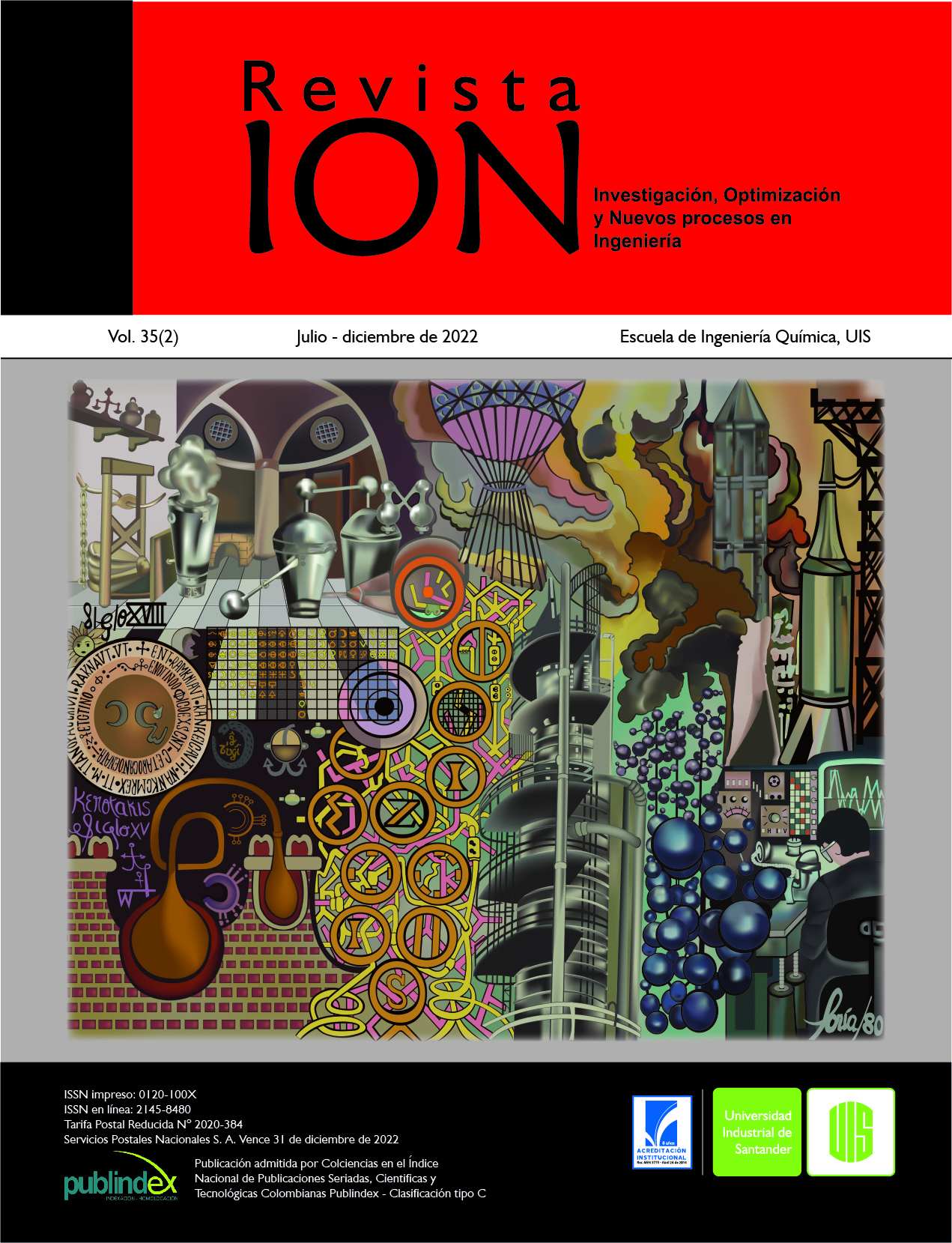Published 2022-12-05
Keywords
- Bio-medical waste,
- Surgical clothes,
- Surgical gloves,
- Thermogravimetric analysis
How to Cite
Copyright (c) 2022 Andrea Elizabeth Cayancela Muñoz, Gabriela Benalcázar Peñafiel, María Alvarado Aguiar, Gilda Graciela Gordillo Vinueza, Carolina del Rocio Montero Calderón

This work is licensed under a Creative Commons Attribution 4.0 International License.
Abstract
Thermogravimetric analysis has established kinetics for the devolatilization of bio sanitary waste as possible sources for alternative fuels. In this study, the thermal degradation of materials was carried out at different heating rates: 5, 15, 30 °C/min with dynamic ramps and isothermal periods in the thermogravimetric analyzer. The data from the mass loss at different times and temperatures, the conversion of the thermal decomposition reaction was calculated, this value was used in three mathematical models that will predict the kinetic parameters such as activation energy, pre-exponential factor, and order of the reaction. A better fit model is proposed by minimizing the error between the calculated thermal degradation rate and the experimental one. It is concluded that the best kinetic model for contaminated clothes and gloves considered the Arrhenius equation and reaction order two and includes reference temperatures of 450 and 367 °C for each material. The activation energy values for contaminated gowns and gloves are 553.62 and 154.06 kJ/mol, respectively. It is established that by achieving a conversion of 0.98 in the thermal degradation of these materials, they can be converted into the material of interest as alternative fuels.
Downloads
References
- Singhal L, Tuli AK, Gautam V. Biomedical waste management guidelines 2016: What’s done and what needs to be done. Indian J. Med. Microbiol. 2017;35(2):194–198. https://doi.org/10.4103/ijmm.IJMM_17_105.
- Ministerio de Salud Pública. Manual de lencería sanitaria para los establecimientos de salud pertenecientes al Ministerio de Salud Pública (Online). Quito, Ecuador: Ministerio de Salud Pública; 2014. Available: https://vlex.ec/vid/apruebase-autorizase-publicacion-documento-551637794.
- Ministerio de Salud Pública. Reglamento Gestión Desechos Generados en Establecimientos de Salud. Ecuador: Ministerio de Salud Pública; 2019. https://www.controlsanitario.gob.ec/wp-content/uploads/downloads/2019/04/Acuerdo-Ministerial-323_Reglamento-para-la-gestión-integral-de-los-residuos-y-desechos-generados-en-los-establecimientos-de-salud.pdf.
- Organización Mundial de la Salud. Desechos de las actividades de atención sanitaria (website). Organización Mundial de la Salud. Available from: https://www.who.int/es/news-room/fact-sheets/detail/health-care-waste Accessed on Feb. 08, 2022.
- INEC, AME, BDE. Boletín Técnico No 04-2020-GAD Municipales: Estadística de Información Ambiental Económica en Gobiernos Autónomos Descentralizados Municipales. Ecuador: Gestión de Estadísticas Agropecuarias y Ambientales basadas en Registros Administrativos (GESARA); 2021.
- Dirección de Estadísticas Agropecuarias y Ambientales. Módulo de Desechos Sanitarios Peligrosos en Establecimientos de Salud del Registro de Recursos y Actividades de Salud, 2016. (Online). Ecuador; 2016. Available from: https://www.ecuadorencifras.gob.ec/documentos/web-inec/Encuestas_Ambientales/Establecimientos_Salud-Residuos_Peligrosos/2016/DocumentotecnicoderesultadosRAS_2016.pdf
- López T. China, la fábrica del mundo: ha exportado 4.000 millones de mascarillas en un mes (Website). La Vanguardia, Madrid. Available from: https://www.lavanguardia.com/economia/20200405/48327032188/chinacoronavirus-exportaciones-mascarillas-testsdeteccion-economia.html
- 3M. 3M está abordando la pandemia del COVID-19 desde todos los ángulos y responsabilidades (Website). 3M España. Available from: https://www.3m.com.es/3M/es_ES/empresa-es/coronavirus/ Accessed on Aug. 26, 2021.
- Servicio Nacional De Gestion De Residuos Y Emergencias. Protocolo de manejo de desechos generados ante evento covid19 (Online). 4 ed. Ecuador: Serv. Nac. Gest. Residuos Y Emergencias; 2020. Available from: https://www.gestionderiesgos.gob.ec/wp-content/uploads/2020/05/Protocolo-demanejo-de-desechos-generados-ante-eventocovid19.pdf Accessed on Jan. 05, 2022.
- UICN. Las secuelas que ha dejado pandemia de COVID-19 en los esfuerzos de conservación (website). WWF. Available from: https://www.wwf.org.ec/?366096/Las-secuelas-que-hadejado-pandemia-de-COVID-19-en-losesfuerzos-de-conservacion Accessed on Aug.26, 2021.
- Fujii PCYS, Gomar GG, Medeiros JM, Borini NK, Makuch DMV. Conhecimento acerca do manejo de resíduos contaminados e potencialmente contaminados por sarscov-2 (SciELO Preprints). 2022. [accessed on 2022 Oct 29]. doi.org/10.1590/SciELOPreprints.3564
- Vilca-Quispe W, Ramírez-Puraca AA, Medina-Sotelo CG, Loa-Navarro E. Residuos Biocontaminantes, otro Legado del COVID-19. Rev. P+L. 2022;16(2)197–211. doi: 10.22507/pml.v16n2a10.
- Jordan-Morales WD, Zurita-Gárces PO. Diseño y Construcción de un Reactor de Pirólisis Térmica, para el Aprovechamiento de Residuos Plásticos de Polipropileno, Generados en la ESPOCH (Undergraduate thesis). Riobamba, Ecuador: Escuela Superior Politécnica del Chimborazo; 2018.
- Klug M. Pirólisis, un proceso para derretir la biomasa. Rev. Química. 2012;26(1-2):37–40.
- Dharmaraj S, Ashokkumar V, Pandiyan R, Munawaroh HSH, Chew KW, Chen WH, et al. Pyrolysis: An effective technique for degradation of COVID-19 medical wastes. Chemosphere. 2021;275:130092.
- Benalcázar GS, Cayancela AE, Determinación de parámetros cinéticos en la devolatilización de materiales residuales biosanitarios (Undergraduate thesis). Quito, Ecuador: Universidad Central del Ecuador; 2019.
- Encalada-Lárraga JA, Jácome-Pilco TL. Determinación de parámetros cinéticos en la devolatilización de biomasa residual de cacao ecuatoriano (Undergraduate thesis). Quito, Ecuador: Universidad Central del Ecuador; 2018 [cited on 2021 Sep 7]. Available from: http://www.dspace.uce.edu.ec/handle/25000/16660
- Rojas-González AF, Carrero-Mantilla JI. Cinética de degradación térmica de poliácido láctico en múltiples extrusiones. Ing. y Univ. 2015;19(1):189–206. doi: 10.11144/Javeriana.iyu19-1.tdkp.
- Popescu C. Integral method to analyze the kinetics of heterogeneous reactions under non-isothermal conditions: A variant on the Ozawa-Flynn-Wall method. Thermochim. Acta. 1998;285(2):309–323. doi: 10.1016/0040-6031(96)02916-4.
- Donoso-Quimbita CA. Evaluación De La Reacción De Descomposición Térmica De Plásticos De Polipropileno Reciclado Como Fuente Alternativa De Combustibles (master's thesis). Escuela Superior Politécnica de Chimborazo; 2019. [cited on 2021 Aug 31]. Available from: http://dspace.espoch.edu.ec/handle/123456789/12387


